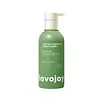What's inside
What's inside
 Key Ingredients
Key Ingredients

No key ingredients
 Benefits
Benefits

No benefits
 Concerns
Concerns

 Ingredients Side-by-side
Ingredients Side-by-side

Water
Skin ConditioningCetearyl Alcohol
EmollientStearamidopropyl Dimethylamine Lactate
Behentrimonium Chloride
PreservativeBetaine
HumectantTrimethylolpropane Tricaprylate/Tricaprate
EmollientPhenoxyethanol
PreservativeParfum
MaskingIsononyl Isononanoate
EmollientIsopropyl Alcohol
SolventSodium Benzoate
MaskingDistearyldimonium Chloride
Guar Hydroxypropyltrimonium Chloride
Skin ConditioningMenthol
MaskingCitric Acid
BufferingDisodium EDTA
Butylene Glycol
HumectantPanthenol
Skin ConditioningArgania Spinosa Kernel Oil
EmollientCamellia Japonica Seed Oil
EmollientSclerocarya Birrea Seed Oil
HumectantZingiber Officinale Root Extract
MaskingAnemarrhena Asphodeloides Root Extract
Skin ConditioningPanax Ginseng Root Extract
EmollientPropylene Glycol
HumectantDiaminopyrimidine Oxide
Skin ConditioningPropanediol
Solvent1,2-Hexanediol
Skin ConditioningAngelica Polymorpha Sinensis Root Extract
Skin ConditioningBiota Orientalis Leaf Extract
HumectantPolygonum Multiflorum Root Extract
Skin ConditioningCaprylyl Glycol
EmollientCaffeine
Skin ConditioningCyclodextrin
AbsorbentHumulus Lupulus Extract
AntimicrobialHydroxyacetophenone
AntioxidantCysteine
AntioxidantChlorphenesin
AntimicrobialGlycine
BufferingCystine
MaskingTryptophan
MaskingSerine
MaskingProline
Skin ConditioningGlutamic Acid
HumectantTyrosine
MaskingPEG-40 Hydrogenated Castor Oil
EmulsifyingEthylhexylglycerin
Skin ConditioningWater, Cetearyl Alcohol, Stearamidopropyl Dimethylamine Lactate, Behentrimonium Chloride, Betaine, Trimethylolpropane Tricaprylate/Tricaprate, Phenoxyethanol, Parfum, Isononyl Isononanoate, Isopropyl Alcohol, Sodium Benzoate, Distearyldimonium Chloride, Guar Hydroxypropyltrimonium Chloride, Menthol, Citric Acid, Disodium EDTA, Butylene Glycol, Panthenol, Argania Spinosa Kernel Oil, Camellia Japonica Seed Oil, Sclerocarya Birrea Seed Oil, Zingiber Officinale Root Extract, Anemarrhena Asphodeloides Root Extract, Panax Ginseng Root Extract, Propylene Glycol, Diaminopyrimidine Oxide, Propanediol, 1,2-Hexanediol, Angelica Polymorpha Sinensis Root Extract, Biota Orientalis Leaf Extract, Polygonum Multiflorum Root Extract, Caprylyl Glycol, Caffeine, Cyclodextrin, Humulus Lupulus Extract, Hydroxyacetophenone, Cysteine, Chlorphenesin, Glycine, Cystine, Tryptophan, Serine, Proline, Glutamic Acid, Tyrosine, PEG-40 Hydrogenated Castor Oil, Ethylhexylglycerin
Zinc Pyrithione 1%
AntiseborrhoeicWater
Skin ConditioningSodium Lauryl Sulfate
CleansingSodium Laureth Sulfate
CleansingGlycol Distearate
EmollientZinc Carbonate
Sodium Chloride
MaskingSodium Xylenesulfonate
Cocamidopropyl Betaine
CleansingParfum
MaskingDimethicone
EmollientSodium Benzoate
MaskingGuar Hydroxypropyltrimonium Chloride
Skin ConditioningMagnesium Carbonate Hydroxide
BufferingMethylchloroisothiazolinone
PreservativeMethylisothiazolinone
PreservativeBlue 1 Lake
Cosmetic ColorantCI 17200
Cosmetic ColorantZinc Pyrithione 1%, Water, Sodium Lauryl Sulfate, Sodium Laureth Sulfate, Glycol Distearate, Zinc Carbonate, Sodium Chloride, Sodium Xylenesulfonate, Cocamidopropyl Betaine, Parfum, Dimethicone, Sodium Benzoate, Guar Hydroxypropyltrimonium Chloride, Magnesium Carbonate Hydroxide, Methylchloroisothiazolinone, Methylisothiazolinone, Blue 1 Lake, CI 17200
 Reviews
Reviews

Ingredients Explained
These ingredients are found in both products.
Ingredients higher up in an ingredient list are typically present in a larger amount.
This ingredient is derived from guar gum.
It is a conditioning ingredient, meaning it helps soften skin and hair.
Parfum is a catch-all term for an ingredient or more that is used to give a scent to products.
Also called "fragrance", this ingredient can be a blend of hundreds of chemicals or plant oils. This means every product with "fragrance" or "parfum" in the ingredients list is a different mixture.
For instance, Habanolide is a proprietary trade name for a specific aroma chemical. When used as a fragrance ingredient in cosmetics, most aroma chemicals fall under the broad labeling category of “FRAGRANCE” or “PARFUM” according to EU and US regulations.
The term 'parfum' or 'fragrance' is not regulated in many countries. In many cases, it is up to the brand to define this term.
For instance, many brands choose to label themselves as "fragrance-free" because they are not using synthetic fragrances. However, their products may still contain ingredients such as essential oils that are considered a fragrance by INCI standards.
One example is Calendula flower extract. Calendula is an essential oil that still imparts a scent or 'fragrance'.
Depending on the blend, the ingredients in the mixture can cause allergies and sensitivities on the skin. Some ingredients that are known EU allergens include linalool and citronellol.
Parfum can also be used to mask or cover an unpleasant scent.
The bottom line is: not all fragrances/parfum/ingredients are created equally. If you are worried about fragrances, we recommend taking a closer look at an ingredient. And of course, we always recommend speaking with a professional.
Learn more about ParfumSodium Benzoate is a preservative. It's used in both cosmetic and food products to inhibit the growth of mold and bacteria. It is typically produced synthetically.
Both the US FDA and EU Health Committee have approved the use of sodium benzoate. In the US, levels of 0.1% (of the total product) are allowed.
Sodium benzoate works as a preservative by inhibiting the growth of bacteria inside of cells. It prevents the cell from fermenting a type of sugar using an enzyme called phosphofructokinase.
It is the salt of benzoic acid. Foods containing sodium benzoate include soda, salad dressings, condiments, fruit juices, wines, and snack foods.
Studies for using ascorbic acid and sodium benzoate in cosmetics are lacking, especially in skincare routines with multiple steps.
We always recommend speaking with a professional, such as a dermatologist, if you have any concerns.
Learn more about Sodium BenzoateWater. It's the most common cosmetic ingredient of all. You'll usually see it at the top of ingredient lists, meaning that it makes up the largest part of the product.
So why is it so popular? Water most often acts as a solvent - this means that it helps dissolve other ingredients into the formulation.
You'll also recognize water as that liquid we all need to stay alive. If you see this, drink a glass of water. Stay hydrated!
Learn more about Water